Effect of Ageing on the Tracking Characteristics of High-Temperature Vulcanized Silicone Rubber Hybrid Composites for High Voltage Insulation
Abstract
1. Introduction
2. Methodology
2.1. Sample Preparation
2.2. Experimental Arrangement
2.3. Research Design
3. Results and Discussions
3.1. Effect of Ageing on the Percentage Weight Change, the Contact Angle and Hydrophobicity
3.2. Analysis of Leakage Current Variations During Tracking
3.3. Analysis of Tracking Length and Loss of Weight after Tracking
3.4. Morphological Studies Using Scanning Electron Microscopy
3.5. Energy-Dispersive X-ray Analysis
3.6. Fourier Transform Infrared (FTIR) Spectroscopy Analysis
4. Conclusions
Author Contributions
Funding
Acknowledgments
Conflicts of Interest
References
- Ahmadi-Joneidi, I.; Majzoobi, A.; Shayegani-Akmal, A.A.; Mohseni, H.; Jadidian, J. Ageing Evaluation of Silicone Rubber Insulators Using Leakage Current and Flashover Voltage Analysis. IEEE Trans. Dielectr. Electr. Insul. 2013, 20, 212–220. [Google Scholar] [CrossRef]
- Haddad, G.; Gupta, R.K.; Wong, K.L. Wong Visualization of Multi-Factor Changes in HTV Silicone Rubber in response to Environmental Exposures. IEEE Trans. Dielectr. Electr. Insul. 2014, 21, 2190–2198. [Google Scholar] [CrossRef]
- Plesa, I.; Notingher, P.; Schlögl, S.; Sumereder, C.; Muhr, M. Properties of polymer composites used in high-voltage applications. Polymers 2016, 8, 173. [Google Scholar] [CrossRef] [PubMed]
- Chakraborty, R.; Reddy, B.S. Studies on High-Temperature Vulcanized Silicone Rubber Insulators under Arid Climatic Ageing. IEEE Trans. Dielectr. Electr. Insul. 2017, 24, 1751–1760. [Google Scholar] [CrossRef]
- Milani, G.; Milani, F. Genetic algorithm for the optimisation of rubber insulated high voltage power cables production lines. Comput. Chem. Eng. 2008, 32, 3198–3212. [Google Scholar] [CrossRef]
- Milani, G.; Milani, F. Optimization of power cable production lines for EPM/EPDM elastomers by genetic algorithm with different peroxides. J. Appl. Polym. Sci. 2009, 111, 482–507. [Google Scholar] [CrossRef]
- Nazir, M.Q.; Phung, B.T.; Yu, S.; Li, S. Effects of Thermal Properties on Tracking and Erosion Resistance of Micro-ATH/AlN/BN filled Silicone Rubber Composites. IEEE Trans. Dielectr. Electr. Insul. 2018, 25, 2076–2085. [Google Scholar] [CrossRef]
- Rajini, V.; Udayakumar, K. Degradation of Silicone Rubber under AC or DC Voltages in Radiation Environment. IEEE Trans. Dielectr. Electr. Insul. 2009, 16, 834–841. [Google Scholar] [CrossRef]
- Verma, A.R.; Reddy, B.S. Ageing Studies on Polymeric Insulators under DC Stress with Controlled Climatic Conditions. Polym. Test. 2018, 68, 185–192. [Google Scholar] [CrossRef]
- Verma, A.R.; Reddy, B.S. Accelerated Ageing Studies of Silicon-Rubber based Polymeric Insulators Used for HV Transmission Lines Science direct. Polym. Test. 2017, 62, 124–131. [Google Scholar] [CrossRef]
- Verma, A.R.; Reddy, B.S. Tracking and erosion resistance of LSR and HTV silicone rubber under acid rain conditions. IEEE Trans. Dielectr. Electr. Insul. 2018, 25, 46–52. [Google Scholar] [CrossRef]
- Verma, A.R.; Reddy, G.S.; Chakraborty, R. Multistress ageing studies on polymeric insulators. IEEE Trans. Dielect. Electr.Insul. 2018, 25, 524–532. [Google Scholar] [CrossRef]
- Kaneko, T.; Ito, S.; Minakawa, T.; Hirai, N.; Ohki, Y. Degradation mechanisms of silicone rubber under different ageing conditions. Polym. Degrad. Stab. 2019, 168, 108936. [Google Scholar] [CrossRef]
- Haddad, A.; Waters, R.T.; Griffiths, H.; Chrzan, K.; Harid, N.; Sarkar, P.; Charalampidis, P. A new approach to anti-fog design for polymeric insulators. IEEE Trans. Dielectr. Electr. Insul. 2010, 17, 343–350. [Google Scholar] [CrossRef]
- Waters, R.T.; Haddad, A.; Griffiths, H.; Harid, N.; Charalampidis, P.; Sarkar, P. Dry-band discharges on polluted silicone rubber insulation: Control and characterisation. IEEE Trans. Dielectr. Electr. Insul. 2011, 18, 1995–2003. [Google Scholar] [CrossRef]
- Slama, M.E.A.; Albano, M.; Haddad, A.; Waters, R.T. Dry-Band Discharges Dynamic at the Surface of SiR Textured Insulator During AC Inclined Plane Test. In Proceedings of the 21st International Symposium on High Voltage Engineering, Budapest, Hungary, 26–30 August 2019; pp. 504–517. [Google Scholar] [CrossRef]
- Tanaka, T.; Imai, T. Advanced Nanodielectrics: Fundamentals and Applications, 1st ed.; Jenny Stanford Publishing: Suntec City, Singapore, 2017. [Google Scholar]
- Tanaka, T.; Kozako, M.; Fuse, N.; Ohki, Y. Proposal of a multi-core model for polymer nanocomposite dielectrics. IEEE Trans. Dielectr. Electr. Insul. 2005, 12, 669–681. [Google Scholar] [CrossRef]
- Lewis, T.J. Interfaces: Nanometric dielectrics. J. Phys. D Appl. Phys. 2005, 38, 202–212. [Google Scholar] [CrossRef]
- Liu, Y.; Zhang, D.; Xu, H.; Ale-Emran, S.M.; Du, B.X. Characteristic analysis of surface damage and bulk micro-cracks of SiR/SiO2 nanocomposites caused by surface arc discharges. IEEE Trans. Dielectr. Electr. Insul. 2016, 23, 2102–2109. [Google Scholar] [CrossRef]
- Du, B.X.; Li, Z.L. Surface charge and dc flashover characteristics of direct-fluorinated SiR/SiO2 nanocomposites. IEEE Trans. Dielectr. Electr. Insul. 2014, 21, 2602–2610. [Google Scholar] [CrossRef]
- Nazir, M.T.; Phung, B.T. Accelerated ultraviolet weathering investigation on micro-/nano-SiO2 filled silicone rubber composites. High Volt. 2018, 3, 295–302. [Google Scholar] [CrossRef]
- Nazir, M.T.; Phung, B.T.; Yu, S.; Li, S. Resistance against AC corona discharge of micro-ATH/nano-Al2O3 co-filled silicone rubber composites. IEEE Trans. Dielectr. Electr. Insul. 2018, 25, 657–667. [Google Scholar] [CrossRef]
- Guo, Y.; Zeng, X.; Lai, X.; Li, H. Enhancement of Tracking and Erosion Resistance of Silicone Rubber with Platinum/Amino-silane by Modulation of Crosslinking Density. IEEE Trans. Dielectr. Electr. Insul. 2018, 25, 741–748. [Google Scholar] [CrossRef]
- Khan, H.; Amin, M.; Ahmad, A. Performance evaluation of alumina trihydrate and silica-filled silicone rubber composites for outdoor high-voltage insulations. Turk. J. Electr. Eng. Comput. Sci. 2018, 26, 2688–2700. [Google Scholar] [CrossRef]
- Khan, H.; Amin, M.; Ahmad, A.; Yasin, M. Investigation of electrical, tracking/erosion, and water absorption resistance properties of ATH-SiO2-reinforced RTV-SiR composites for high-voltage insulations. J. Elastom. Plast. 2018, 50, 501–519. [Google Scholar] [CrossRef]
- Jeon, Y.; Hong, S.K.; Kim, M. Effect of Filler Concentration on Tracking Resistance of ATH-Filled Silicone Rubber Nanocomposites. Energies 2019, 12, 2401. [Google Scholar] [CrossRef]
- Loganathan, N.; Muniraj, C.; Chandrasekar, S. Tracking and erosion resistance performance investigation on nano-sized SiO2 filled silicone rubber for outdoor insulation applications. IEEE Trans. Dielectr. Electr. Insul. 2014, 21, 2172–2180. [Google Scholar] [CrossRef]
- Suchitra, M.; Renukappa, N.M.; Ranganathaiah, C.; Rajan, J.S. Correlation of free space length and surface energy of epoxy nanocomposites to surface tracking. IEEE Trans. Dielectr. Electr. Insul. 2018, 25, 2129–2138. [Google Scholar] [CrossRef]
- Zhang, H.; Yang, H.; Shentu, B. Effect of surface modification of titanium dioxide on the UV-C ageing behaviour of silicone rubber. J. Appl. Polym. Sci. 2019, 136, 47170. [Google Scholar] [CrossRef]
- Rashid, A.; Amin, M.; Ali, M.; Khattak, A. Ageing exploration of long term multi stressed HTV-silicone rubber/silica/alumina composites for high voltage insulation. Mater. Res. Express 2018, 5, 095301. [Google Scholar] [CrossRef]
- Rashid, A.; Amin, M.; Ali, M.; Khattak, A.; Saleem, J. Fabrication, characterisation and ageing influence on characteristics of high temperature vulcanised silicone rubber/silica hybrid composites for high voltage insulation. Mater. Res. Express 2019, 6, 105327. [Google Scholar] [CrossRef]
- IEC. Electrical Insulating Materials Used Under Severe Ambient Conditions-Test Methods for Evaluating Resistance to Tracking and Erosion, 3rd ed.; IEC: Geneva, The Switzerland, 2007. [Google Scholar]
- ASTM International. ASTM D2303-13 Standard Test Methods for Liquid-Contaminant, Inclined-Plane Tracking and Erosion of Insulating Materials; ASTM International: West Conshohocken, PA, USA, 2013. [Google Scholar] [CrossRef]
- Vas, J.V.; Venkatesulu, B.; Thomas, M.J. Tracking and erosion of silicone rubber nanocomposites under DC voltages of both polarities. IEEE Trans. Dielectr. Electr. Insul. 2012, 19, 91–98. [Google Scholar] [CrossRef]
- Milani, G.; Milani, F. Comprehensive numerical model for the interpretation of cross-linking with peroxides and sulfur: Chemical mechanisms and optimal vulcanisation of real items. Rubber Chem. Technol. 2012, 85, 590–628. [Google Scholar] [CrossRef]
- Shaik, M.G.; Karuppaiyan, V. Investigation of Surface Degradation of Aged High-Temperature Vulcanized (HTV) Silicone Rubber Insulators. Energies 2019, 12, 3769. [Google Scholar] [CrossRef]

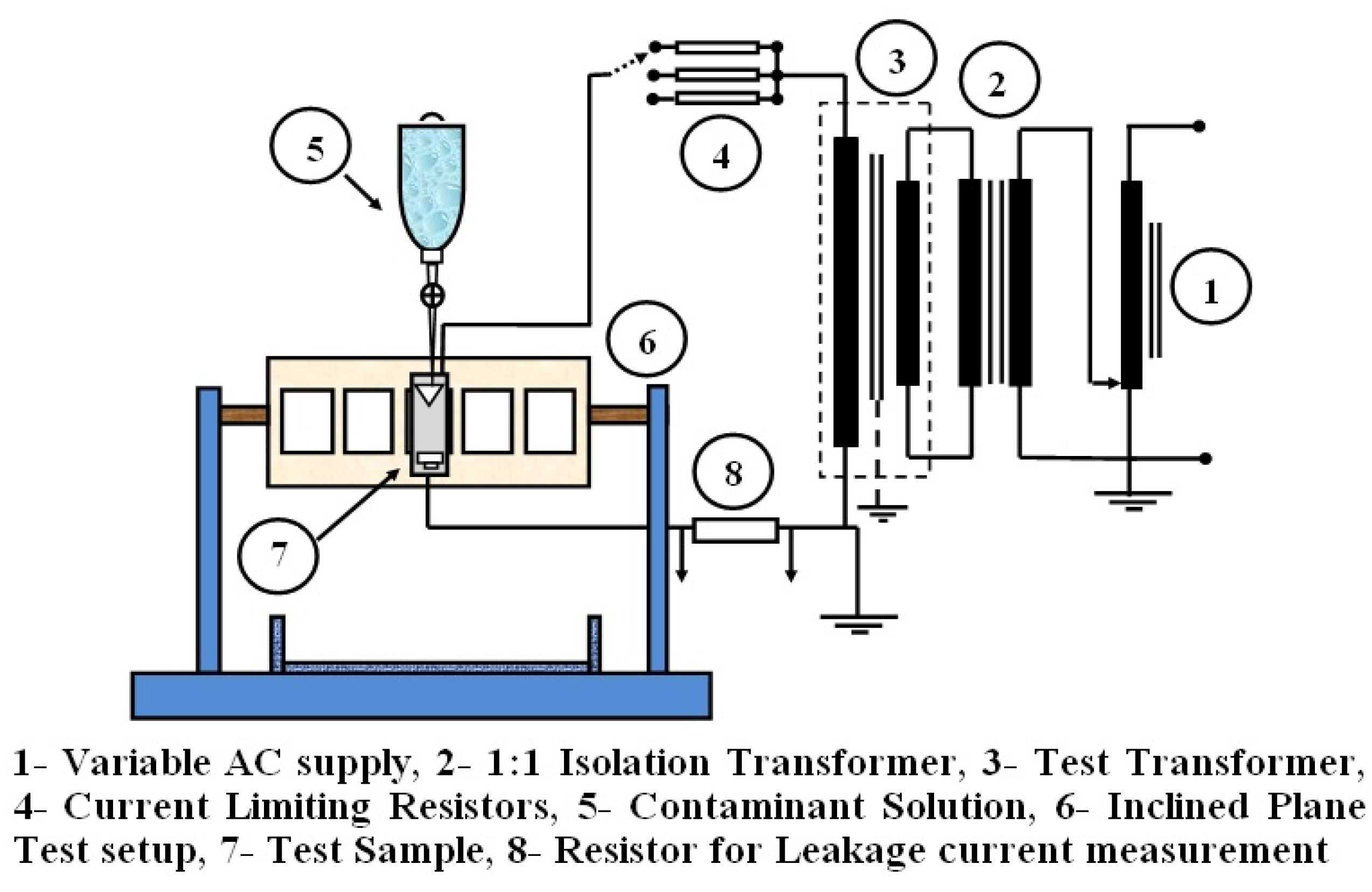

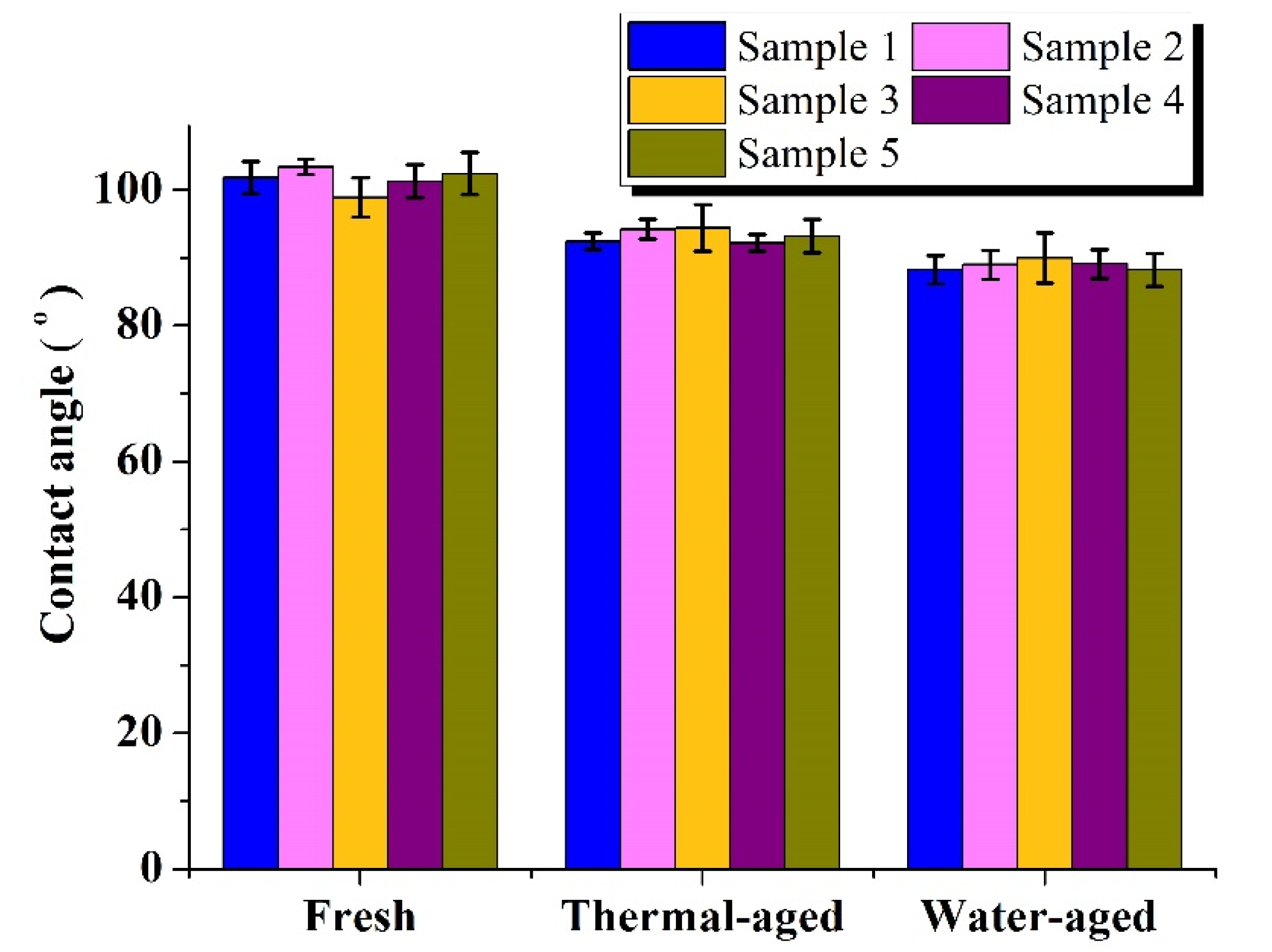

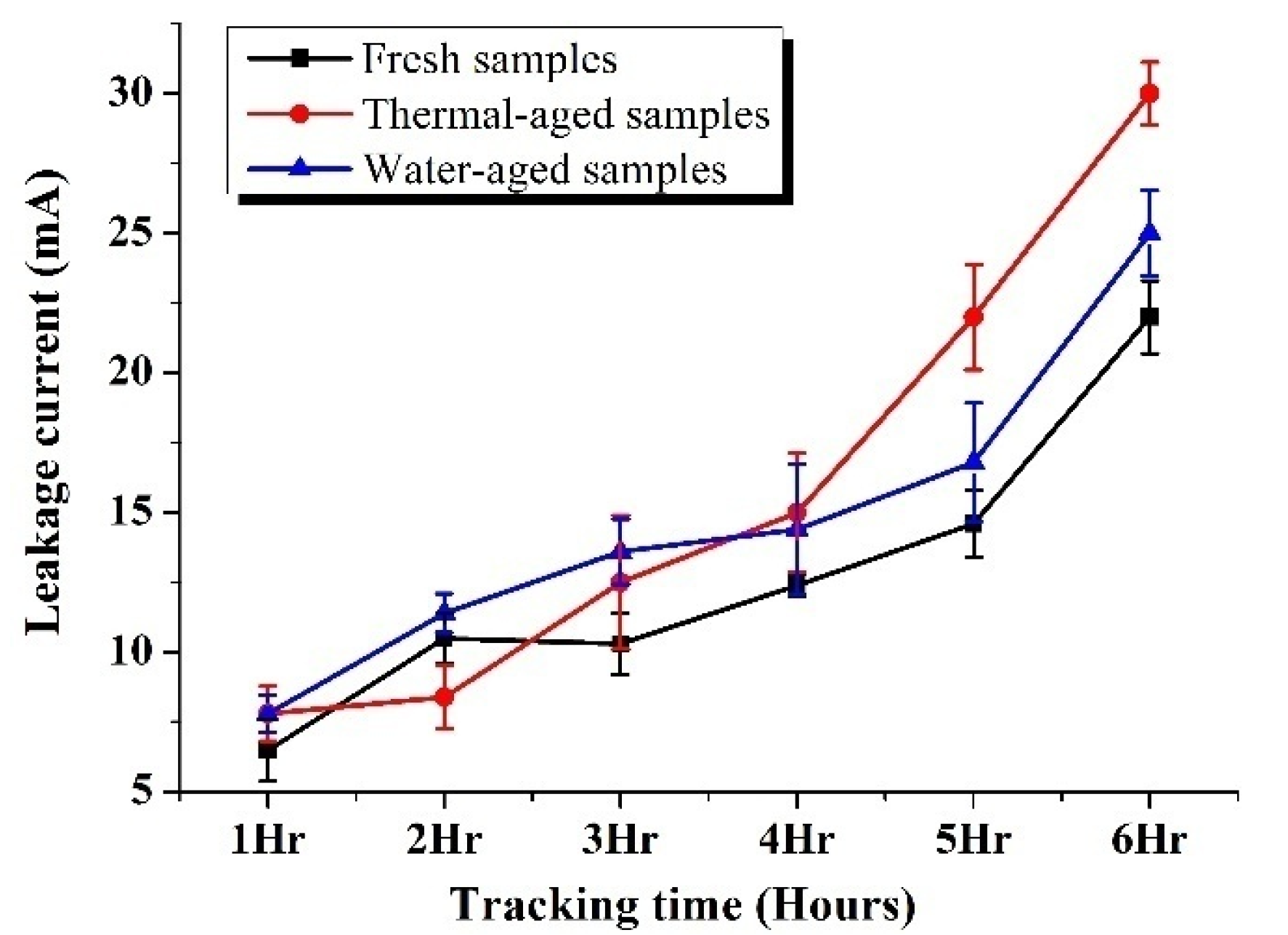

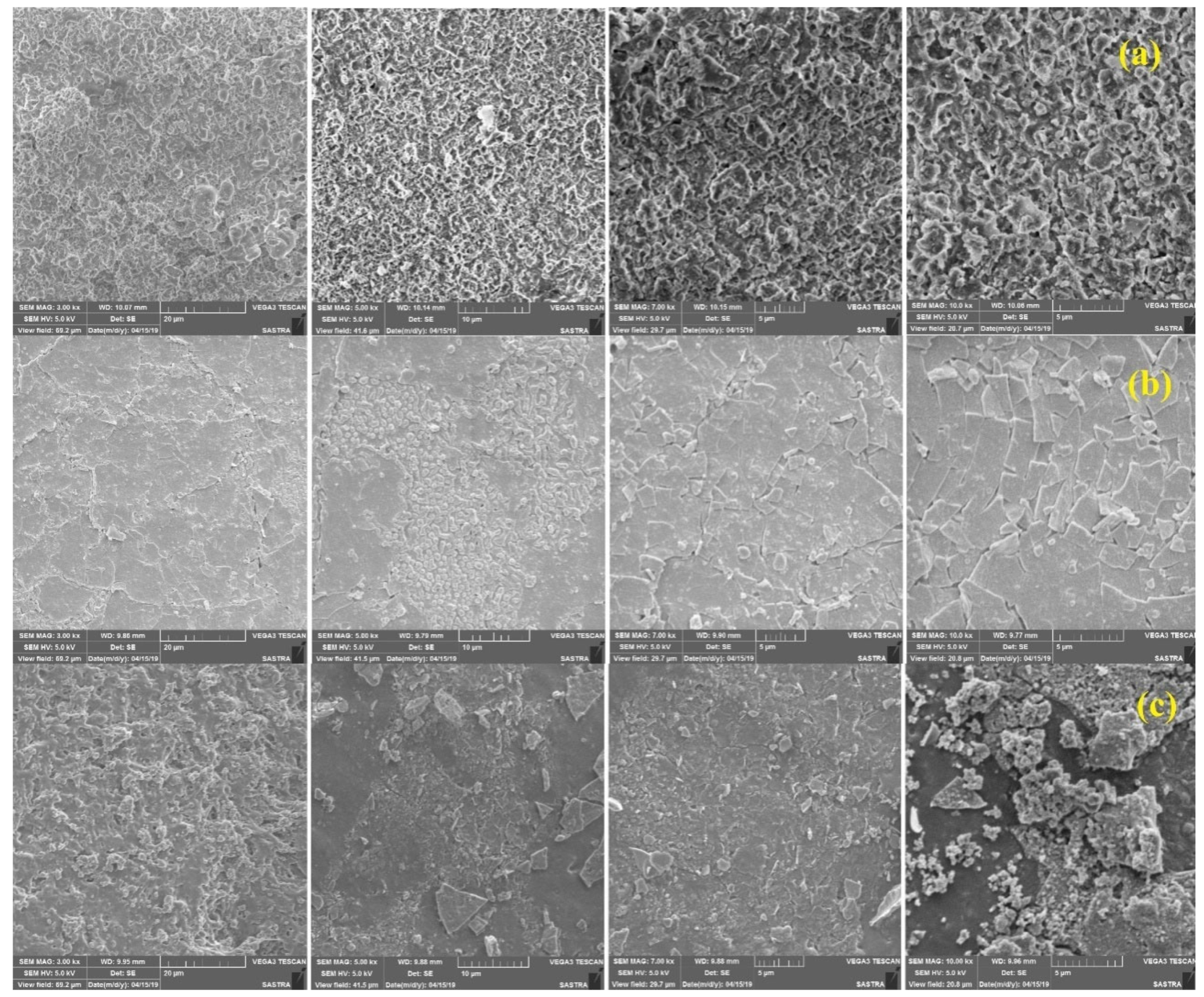
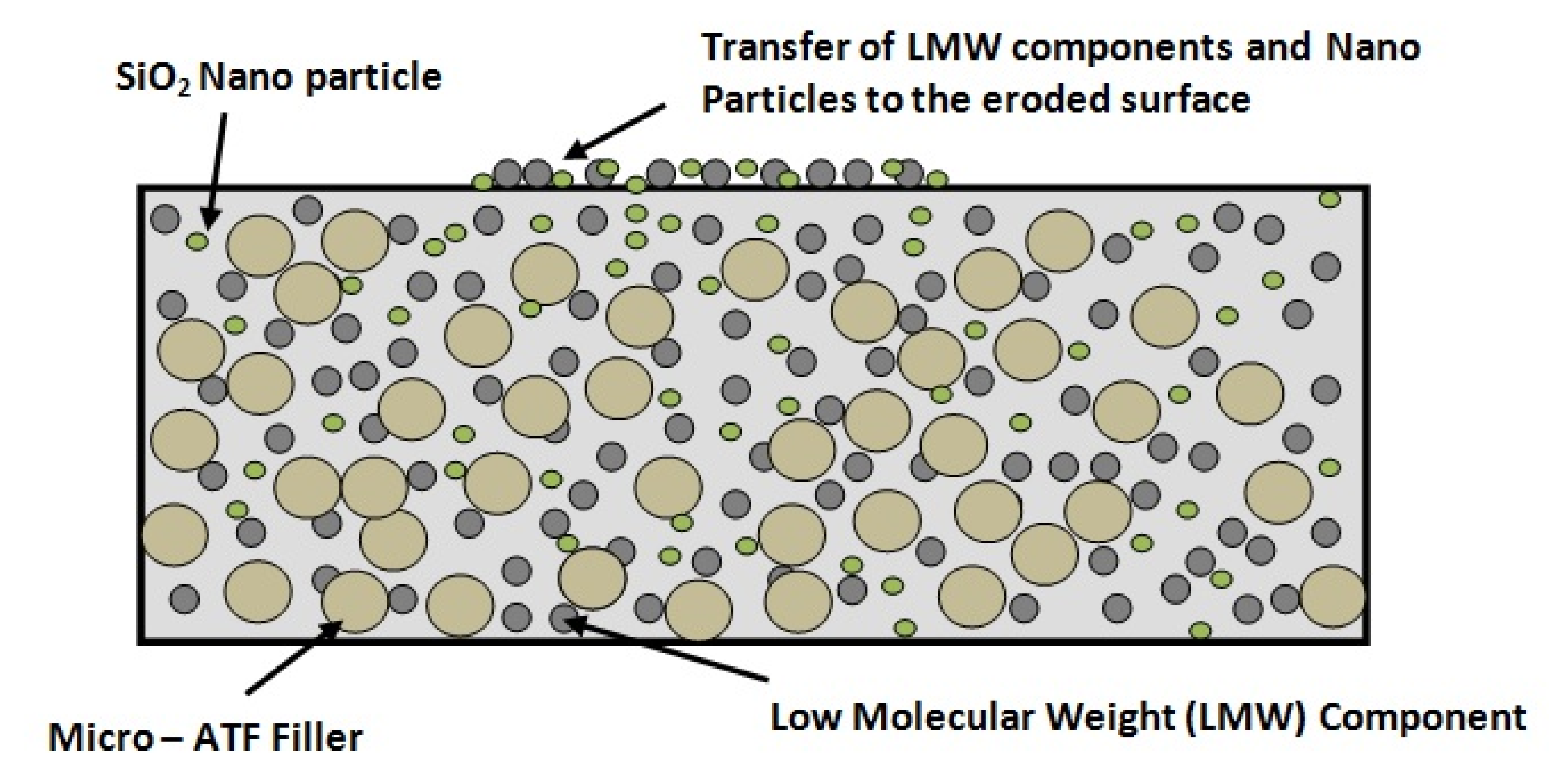
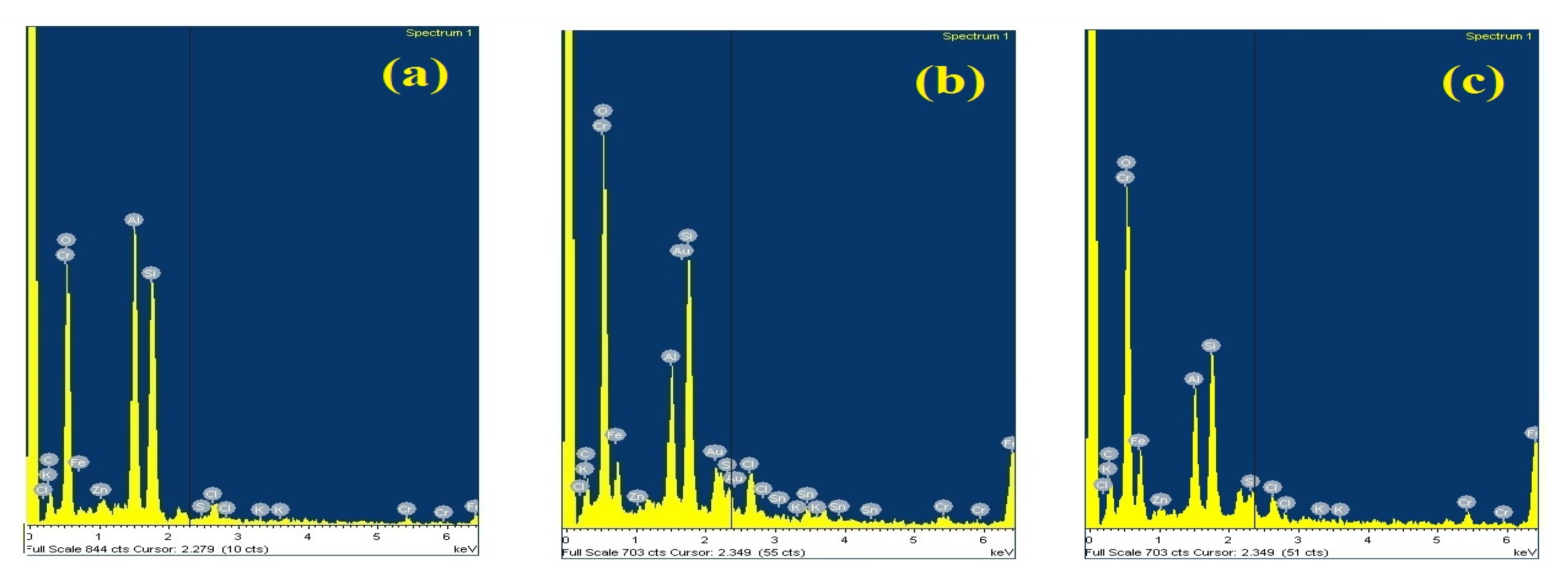

| Water Aged (mg) | Thermal Aged (mg) | ||
|---|---|---|---|
| Before Ageing | After Ageing | Before Ageing | After Ageing |
| Average weight 21,647.4 | Average weight 22,816.4 | Average weight 24,759.6 | Average weight 24,737.3 |
| Standard deviation 1123.3 | Standard deviation 1187.5 | Standard deviation 1326.7 | Standard deviation 1275.4 |
| % Weight gain = 5.4% | % Weight Loss = 0.09% | ||
| Sample Type | Average Tracking Length (cm) | Average Weight Loss (%) |
|---|---|---|
| Fresh samples | 2.2 | 1.11 |
| Thermal-aged samples | 2.9 | 1.45 |
| Water-aged samples | 3.1 | 1.32 |
| Elements | Fresh | Thermal-Aged | Water-Aged | |
|---|---|---|---|---|
| C | weight% | 9.24 | 9.32 | 8.00 |
| atomic% | 26.95 | 24.81 | 26.40 | |
| O | weight% | 24.96 | 29.75 | 23.17 |
| atomic% | 54.68 | 59.47 | 57.39 | |
| Al | weight% | 6.90 | 2.82 | 2.81 |
| atomic% | 8.96 | 3.34 | 4.13 | |
| Si | weight% | 6.49 | 5.27 | 3.58 |
| atomic% | 8.10 | 6.00 | 5.05 | |
| S | weight% | 0.14 | 0.58 | 0.46 |
| atomic% | 0.16 | 0.58 | 0.57 | |
| Cl | weight% | 0.14 | 1.23 | 0.55 |
| atomic% | 0.53 | 1.11 | 0.62 | |
| K | weight% | 0.14 | 0.01 | 0.04 |
| atomic% | 0.02 | 0.01 | 0.04 | |
| Cr | weight% | 0.14 | 0.35 | 0.76 |
| atomic% | 0.22 | 0.22 | 0.58 | |
| Fe | weight% | 0.14 | 5.93 | 7.07 |
| atomic% | 0.52 | 3.39 | 5.02 | |
| Zn | weight% | 0.14 | 0.36 | 0.33 |
| atomic% | 0.23 | 0.17 | 0.20 | |
© 2020 by the authors. Licensee MDPI, Basel, Switzerland. This article is an open access article distributed under the terms and conditions of the Creative Commons Attribution (CC BY) license (http://creativecommons.org/licenses/by/4.0/).
Share and Cite
Ghouse Shaik, M.; Karuppaiyan, V. Effect of Ageing on the Tracking Characteristics of High-Temperature Vulcanized Silicone Rubber Hybrid Composites for High Voltage Insulation. Materials 2020, 13, 2242. https://doi.org/10.3390/ma13102242
Ghouse Shaik M, Karuppaiyan V. Effect of Ageing on the Tracking Characteristics of High-Temperature Vulcanized Silicone Rubber Hybrid Composites for High Voltage Insulation. Materials. 2020; 13(10):2242. https://doi.org/10.3390/ma13102242
Chicago/Turabian StyleGhouse Shaik, Mohamed, and Vijayarekha Karuppaiyan. 2020. "Effect of Ageing on the Tracking Characteristics of High-Temperature Vulcanized Silicone Rubber Hybrid Composites for High Voltage Insulation" Materials 13, no. 10: 2242. https://doi.org/10.3390/ma13102242
APA StyleGhouse Shaik, M., & Karuppaiyan, V. (2020). Effect of Ageing on the Tracking Characteristics of High-Temperature Vulcanized Silicone Rubber Hybrid Composites for High Voltage Insulation. Materials, 13(10), 2242. https://doi.org/10.3390/ma13102242





